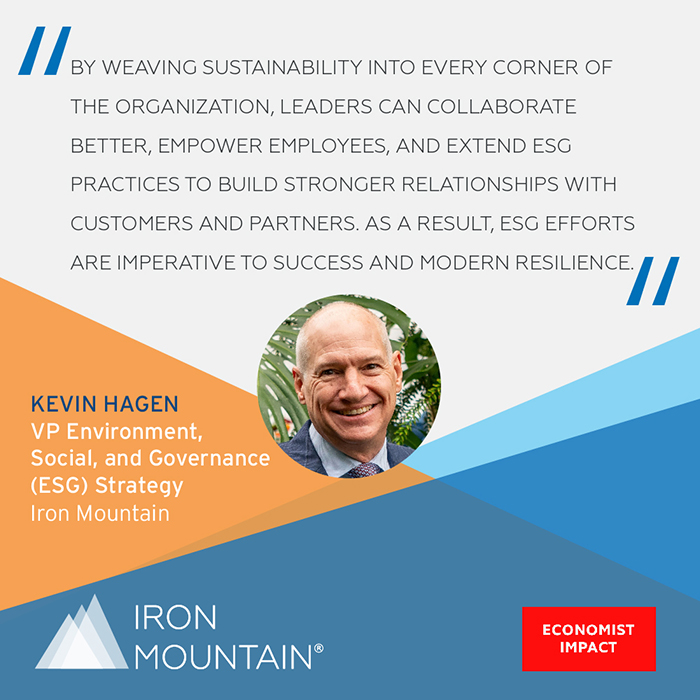How ESG thrived through the pandemic and what we learned from it
When ESG is ingrained in our everyday work processes, it becomes a core driver of your organization’s resilience.

So it’s understandable avoiding the reduction of natural resources in an efficient manner. That's sustainability, right? It's safe to say that's what most people think. So it's understandable for organizations to naturally gravitate toward having more environment-led initiatives when they talk about sustainability. However, that only pertains to the E in ESG — environmental, social, and governance — the three key pillars of "sustainability."
The concept of ESG grew out of the 2004 United Nations report, Who Cares Wins. This report established ESG as the necessary focus area to ensure stronger investment markets and the sustainable development of society.
From then on, we’ve seen more and more stakeholders (investors, customers, employees, etc.) asking questions about ESG and how to drive it within their organizations. These groups are also seeking to do more business with other organizations that have strong and transparent ESG programs.
And while some may use the terms sustainability and ESG interchangeably, each area stands on its own:
-
Environmental: The energy your company takes in and the waste it discharges, the resources it needs, and the consequences for living beings as a result.*
-
Social: The relationships your company has and the reputation it fosters with people and institutions in the communities where you do business.* A main component of social initiatives include supporting employees and building strong Diversity, Equity, and Inclusion (DEI) initiatives.
-
Governance: Internal system of practices, controls, and procedures your company adopts in order to govern itself, make effective decisions, comply with the law, and meet the needs of external stakeholders.*
From the disposition of electronic devices to the paper you recycle, and even to the energy consumed by your data centers, there’s an ESG component to consider.
And when ESG is ingrained in your everyday work processes, it becomes a core driver of your organization’s resilience.

How the pandemic reinforced ESG-led initiatives
Organizations have been well aware of the importance of sustainability for years. In fact, nearly half of respondents to our Economist Impact survey indicated that they implemented ESG initiatives prior to the pandemic. But something happened over the course of the pandemic that ramped up global efforts, with sustainability now one of the top five priorities for organizations.
With more people working remotely, the supply chain undergoing a major stress test, and employee well-being coming into focus, organizations have reevaluated their ESG efforts.
For example, while 44% of organizations prioritized dedicated sustainability staff and resources to foster resilience just a few years ago, that number jumped up to nearly 78% since the pandemic. Because of this increase in sustainability staff, ESG-led initiatives can be achieved at a larger, more rapid scale. And, as a result, 67% of organizations believe they’re ahead of their peers in making progress toward their ESG goals and commitments.
How the pandemic highlighted ESG-driven resilience (or lack thereof)
Building organizational resilience is complex at the best of times. Until organizations are pushed to their limits, there’s no clear way to know how resilient they are. There’s also no motivating factor to test the limits.
When it came to the pandemic, organizations needed to figure out a way to continue their business operations under duress. And they weren’t alone—the entire world was going through the same thing at the same time. However, those with ESG initiatives already in motion had a protective layer.
Organizations discovered they needed to focus more attention on these areas to strengthen their ESG (and resilience) efforts:
-
Supply chain visibility
-
Assessment and awareness of climate change
-
Employee engagement and flexibility
7 elements of a sustainable business resilience plan
- Cross-functional collaboration and planning–Operational efficiency
- Information sharing between departments–Data governance & security
- Employee well-being and engagement–Workplace transformation
- Decision-making architectures and measurement–Operational efficiency
- Balancing resilience and efficiency–Operational efficiency
- Adapting to new technology–Data governance & security
- Meeting sustainability targets–Sustainability
Where ESG goes from here—lessons learned
While nearly 95% of those surveyed in our research with Economist Impact are confident their sustainability initiatives can support resilience and continuity in the event of a significant, unexpected disruption, there are still areas for improvement.
Through our research, we discovered what’s needed to strengthen ESG-driven resilience in the future:
-
Supply chain visibility: 60% believe improvement in transparency is necessary. So get involved with your supply chain vendors. Ask questions about their ESG efforts. They may have their own ESG reports to highlight what they’re doing to be more sustainable.
-
Assessment and awareness of climate change risk: 62% believe more can be done in this area. Organizations can conduct a climate-scenario analysis and report on the results to show they understand their risks and are working to mitigate them. These types of initiatives are likely to become standard in the future.
-
Focusing on employee well-being: During the pandemic, this area rose from to the top of the list for organizations. It highlighted the need for organizations to become more flexible, enable remote work, provide a safe return-to-office plan, and prioritize employees’ mental health.
-
Everyone has a role to play: ESG has moved from a niche focus area to how an organization does everything. Many organizations are now assigning key performance indicators associated with ESG as part of employees’ annual performance evaluations, no matter job title or function.
ESG initiatives are no longer a nice-to-have but a necessary part of helping organizations ensure resilience for an unknown future. To gain a better understanding of how to boost your ESG objectives, visit our Sustainability page.
*McKinsey Quarterly. Five ways that ESG creates value. November 2019.
Featured services & solutions
Rethink sustainability
At Iron Mountain, we strive to be our customers’ most trusted partner for protecting and unlocking the value of what matters most to them in innovative and socially responsible ways
Resilience reimagined
Are organizations ready to face the next unknown? This report, co-sponsored by The Economist and Iron Mountain, helps to answer that question.
Related resources
View More Resources


